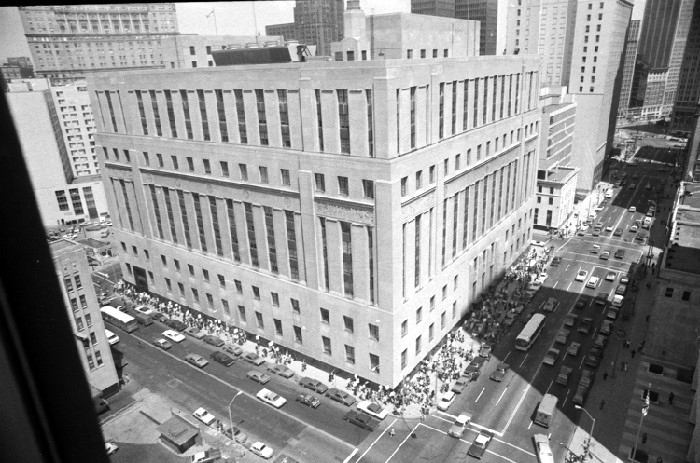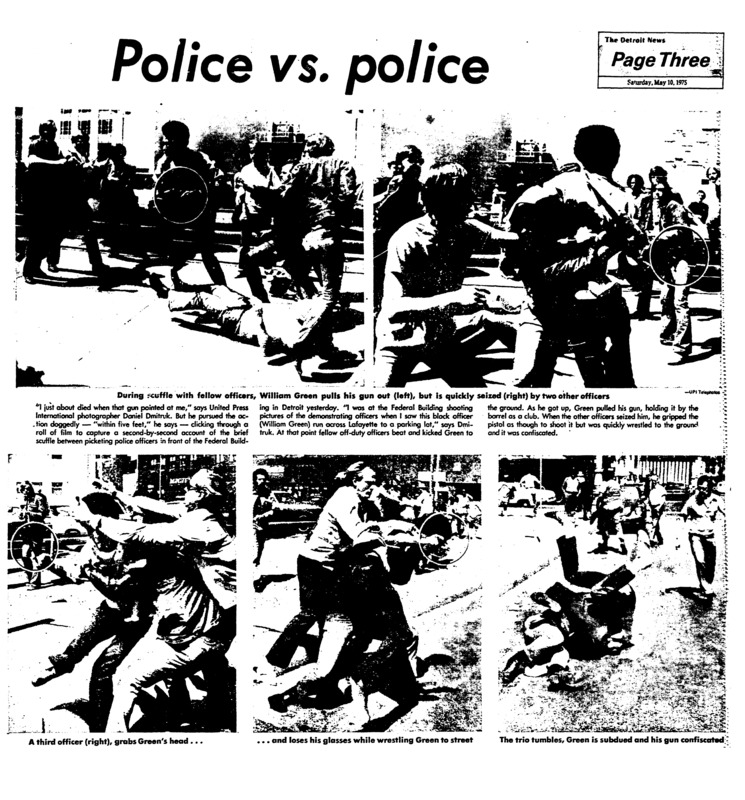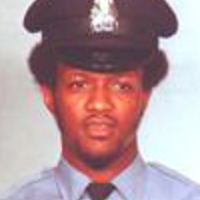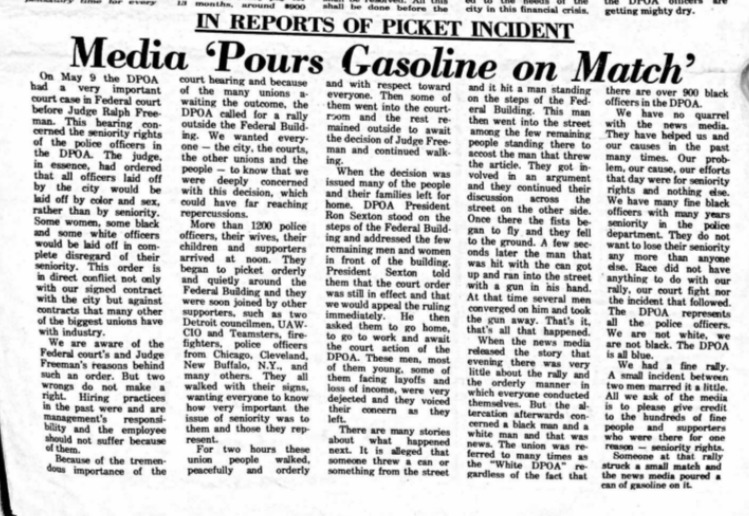IN FOCUS: The Assault of William Green
In the Spring of 1975, the city was facing severe budget problems and as a result, Mayor Coleman Young decided to layoff several hundred police officers. That decision, however, created another challenge for Young’s administration. Young had, since his election, been working to make the police department better represent the demographics of Detroit as a whole by using affirmative action policies to hire more black and female officers. The problem was that police layoffs had traditionally been determined by officer seniority. In order to avoid erasing the progress he had made on the integration of the police department Young exempted some black and female officers from being laid off.
Young's decision to keep his affirmative action gains intact at the expense of more senior officers was challenged by the Detroit Police Officers Association in federal court. On May 9th, as U.S District Court Judge Ralph M. Freeman was reaching a decision in the case, over 1000 off duty Detroit police officers gathered around the federal courthouse in a demonstration against the layoffs and Young’s protection of affirmative action gains.
Later that afternoon, with a large number of picketers still outside the courthouse, it was announced that the District Court Judge had approved the majority of the non-seniority based layoffs. Some within the crowd of mostly white police protesters reacted with angry outbursts. One white, off-duty threw a beer can at a young black officer named William Green who was also off-duty and at the courthouse. Green then got into a scuffle with a group of white officers who assaulted him and threw him to the pavement. As Green was getting up he pulled out his service revolver to defend himself from the onslaught. Two white officers then tackled him to the ground again and took his weapon.
A reporter on the scene managed to capture sequential photographs of part of the white officer’s assault of William Green. These photographs were then published in the Detroit News the next day. The framing of the incident in the Detroit News as well as in the DPOA’s own magazine pictured further down this page provide a great deal of insight into the ways that white Detroiters during this time period resisted the push for integration of the police department by decontextualizing individual incidents and policies to obfuscate their underlying racial histories.
In the Detroit News coverage of William Green’s assault, Green was portrayed not as a victim but as an active participant in, or instigator of the fight. The headline “Police vs. police” assigns equal responsibility to Green as it does to the group of white officers who assaulted him. The description and photographs of the incident published in the News didn’t begin with a white officer throwing a beer can at Green, nor with the group of white officers throwing Green to the ground. Instead, the Detroit News staff writers chose to throw their readers into the middle of the scuffle, just as Green drew his weapon, without explaining the events that took place immediately before. The sequential photographs start with an image that shows Green standing and taking out his gun. Although the photographer is quoted in the article, explaining that Green had been beaten to the ground before drawing his weapon, the News fails to give much of a description of the events prior to Green pulling out his pistol. In fact, one of the most surprising features of this article is how short it is. One would think that the beating of a black police officer by a crowd of white officers would garner more thorough reporting on the incident. Furthermore, the caption on the last photo reads “Green is subdued” which seems to portray him as the instigator of the violence.
The Detroit News’ downplaying of the assault of William Green was quite similar to that of the DPOA itself. After the incident the DPOA published an article in their union’s magazine Tuebor which minimized both the racial violence that occured at the May 9th protest and denied the protest’s connection to any racial issues at all. The article, pictured below, also criticized the media’s representations of the protest as being overly focused on the William Green incident despite the fact that most of the coverage in the Detroit News was focused on officer’s threats of a walkout in response to the court ruling and only had a small section dedicated to the racial violence. In fact, the Detroit Free Press issue on the day after the protest had very similar coverage, largely focused on the court issues rather than the violence of white DPOA members at the protest. Tuebor, therefore, seems to have been taking issue with any media coverage of the assault of William Green.
Tuebor also made a concerted effort to obfuscate the racial nature of their protests against Coleman Young’s affirmative action protections. The article goes as far as explicitly stating that the DPOA protests had nothing to do with racial issues, emphasizing instead the union’s efforts to protect seniority as the method of determining layoffs. Seniority, however, was clearly linked with racial issues, as prior to Young’s election in 1973 black officers made up a tiny percent of the police force relative to their population in the city as a whole. The DPOA’s denial of the racial components of the seniority issue, somewhat ironically, reveals that they were very conscious of the racial effects that basing layoffs on seniority would have on the composition of the police force in Detroit. Their attempts to downplay the violence at the rally and criticize any media coverage of that violence also show that they were actively trying to cover up the assault of William Green as opposed to condemning it or at the very least distancing themselves from it.
Despite media and DPOA representations of the incident, 12 police officers were charged with crimes ranging from destruction of property to assault as a result of violence stemming from the May 9th protest.
Citizens’ portrayals of the incident differed substantially from the DPOA’s and even the Detroit New’s. Reader editorials published in The Free Press, show that some citizens were angered and disappointed by police actions. One citizen, RIchard Ades, who apparently was present at the protest heard the officers who assaulted William Green making racist comments. In fact, Ades continued to write that “[The N-Word] was the most common word I heard that afternoon. It was a racist crowd, and the demonstration was largely racist-motivated. It’s no wonder it ended in a racist beating.” This directly contrasts with the DPOA’s claim in their magazine that: “Race did not have anything to with our rally, our court fight nor the incident that followed.” Another citizen editorial explained that they felt: “Police are playing games with our lives.”
The William Green incident demonstrates the extreme actions that white officers and the DPOA were willing to go to in order to resist Mayor Young’s affirmative action programs. Resistance to these reforms, although constant, was never more intense than when jobs were on the line. From 1974 until the mid 80’s the Detroit Police Officer’s Union, despite their claims in Tuebor of representing both black and white officers, pursued every possible legal avenue to block the forced integration of the Detroit Police Department. When budget problems initiated waves of layoffs in 1975 and 1976 the resistance became even stronger, with officers threatening walkouts during in 1975 and an unofficial strike leaving the Department severely understaffed in June of 1976. As shown by the assault of William Green, white officers were even willing to commit acts of racial violence in their attempts to block the integration of the police force. Change was coming, but it would require a long and costly struggle to get the Detroit Police Department to reflect the demographics of the city they were in charge of policing.
Sources:
Virtual Motor City, Walter P. Reuther Library, Archives of Labor and Urban Affairs, Wayne State University.
The Detroit News, NewsBank.
Labor History Archives, Walter P. Reuther Library, Wayne State University.
The Detroit Free Press, Proquest Historical Newspapers.





